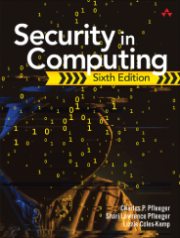
عنوان:
Security in Computing 6th Edition
نویسنده:
Charles P. Pfleeger; Shari Lawrence Pfleeger; Lizzie Coles-Kemp
انتشارات:
Addison-Wesley
تاریخ انتشار:
2024
حجم:
11.6MB
معرفی کتاب:" امنیت در محاسبات – ویرایش ششم "
«وضعیت جدید و پیشرفته امنیت اطلاعات: از ابر تا رمزنگاری، از هوش مصنوعی تا محاسبات پسا-کوانتومی»
کتاب امنیت در محاسبات (Computer Security) در ویرایش ششم خود بهروزرسانی گستردهای دریافت کرده و به عنوان یکی از منابع اصلی برای آموزش و اجرای امنیت اطلاعات شناخته میشود. این کتاب با ساختاری مدرن و علمی، به شما کمک میکند مفاهیم اساسی، ابزارها، روشها و فناوریهای نوظهور در حوزه امنیت سایبری را درک و پیادهسازی کنید.
ویژگیهای کلیدی:
-
پوشش کامل موضوعات جدید و پیشرفته:
- امنیت مبتنی بر هوش مصنوعی و یادگیری ماشین
- امنیت اپلیکیشنها و مرورگرها
- امنیت طراحیشده (Security by Design)
- امنیت ابر، IoT و سیستمهای تعبیهشده
- رمزارزها و بلاکچین
- محاسبات پسا-کوانتومی
- فناوریهای افزایش حریم خصوصی (PETs)
-
نقشهبرداری با چارچوبهای امنیتی معتبر:
- چارچوب آموزشی NIST Cybersecurity
- چارچوب دانش CyBOK
موضوعات اصلی کتاب:
- مفاهیم پایه امنیت اطلاعات: تهدید، آسیبپذیری، کنترل، CIA
- ابزارهای کلیدی: احراز هویت، کنترل دسترسی، رمزنگاری
- امنیت در سطوح مختلف: نرمافزار، شبکه، سیستمعامل، داده، ابر
- موضوعات میانرشتهای: حریم خصوصی، حقوق، اخلاق
- کاربردهای رمزنگاری: نظریه و پیادهسازی عملی
- تهدیدات نوظهور: جنگ سایبری، رمزارز، کوانتوم
هشدار مهم:
استفادهی سطحی از رمزنگاری میتواند خطرناک باشد. طراحی سیستمهای رمزنگاری امن نیازمند تخصص عمیق در ریاضیات و علوم کامپیوتر است و حتی متخصصان نیز ممکن است اشتباه کنند. بنابراین، رمزنگاری را باید به متخصصان واقعی سپرد.
مخاطبان:
این کتاب برای دانشجویان علوم کامپیوتر، مهندسان امنیت، توسعهدهندگان نرمافزار، مدیران فناوری و پژوهشگران حوزه امنیت اطلاعات طراحی شده است که به دنبال نگاهی جامع، کاربردی و آیندهنگرانه به امنیت هستند.
فهرست مطالب
- Cover Page
- About This eBook
- Halftitle Page
- Title Page
- Copyright Page
- Pearson’s Commitment to Diversity, Equity, and Inclusion
- Contents
- Foreword
- Preface
- Acknowledgments
- About the Authors
- 1. Introduction
- 1.1 What Is Computer Security?
- 1.2 Threats
- 1.3 Harm
- 1.4 Vulnerabilities
- 1.5 Controls
- 1.6 Conclusion
- 1.7 What’s Next?
- 1.8 Exercises
- 2. Toolbox: Authentication, Access Control, and Cryptography
- 2.1 Authentication
- 2.2 Access Control
- 2.3 Cryptography
- 2.4 Conclusion
- 2.5 Exercises
- 3. Programs and Programming
- 3.1 Unintentional (Nonmalicious) Programming Oversights
- 3.2 Malicious Code—Malware
- 3.3 Countermeasures
- 3.4 Conclusion
- 3.5 Exercises
- 4. The Internet—User Side
- 4.1 Browser Attacks
- 4.2 Attacks Targeting Users
- 4.3 Obtaining User or Website Data
- 4.4 Mobile Apps
- 4.5 Email and Message Attacks
- 4.6 Conclusion
- 4.7 Exercises
- 5. Operating Systems
- 5.1 Security in Operating Systems
- 5.2 Security in the Design of Operating Systems
- 5.3 Rootkits
- 5.4 Conclusion
- 5.5 Exercises
- 6. Networks
- 6.1 Network Concepts
- Part I—War on Networks: Network Security Attacks
- 6.2 Threats to Network Communications
- 6.3 Wireless Network Security
- 6.4 Denial of Service
- 6.5 Distributed Denial of Service
- Part II—Strategic Defenses: Security Countermeasures
- 6.6 Cryptography in Network Security
- 6.7 Firewalls
- 6.8 Intrusion Detection and Prevention Systems
- 6.9 Network Management
- 6.10 Conclusion
- 6.11 Exercises
- 7. Data and Databases
- 7.1 Introduction to Databases
- 7.2 Security Requirements of Databases
- 7.3 Reliability and Integrity
- 7.4 Database Disclosure
- 7.5 Data Mining and Big Data
- 7.6 Conclusion
- 7.7 Exercises
- 8. New Territory
- 8.1 Introduction
- 8.2 Cloud Architectures and Their Security
- 8.3 IoT and Embedded Devices
- 8.4 Cloud, IoT, and Embedded Devices—The Smart Home
- 8.5 Smart Cities, IoT, Embedded Devices, and Cloud
- 8.6 Cloud, IoT, and Critical Services
- 8.7 Conclusion
- 8.8 Exercises
- 9. Privacy
- 9.1 Privacy Concepts
- 9.2 Privacy Principles and Policies
- 9.3 Authentication and Privacy
- 9.4 Data Mining
- 9.5 Privacy on the Internet
- 9.6 Email and Message Security
- 9.7 Privacy Impacts of Newer Technologies
- 9.8 Conclusion
- 9.9 Exercises
- 10. Management and Incidents
- 10.1 Security Planning
- 10.2 Business Continuity Planning
- 10.3 Handling Incidents
- 10.4 Risk Analysis
- 10.5 Physical Threats to Systems
- 10.6 New Frontiers in Security Management
- 10.7 Conclusion
- 10.8 Exercises
- 11. Legal Issues and Ethics
- 11.1 Protecting Programs and Data
- 11.2 Information and the Law
- 11.3 Rights of Employees and Employers
- 11.4 Redress for Software Failures
- 11.5 Computer Crime
- 11.6 Ethical Issues in Computer Security
- 11.7 An Ethical Dive into Artificial Intelligence
- 11.8 Incident Analyses with Ethics
- 11.9 Conclusion
- 11.10 Exercises
- 12. Details of Cryptography
- 12.1 Cryptology
- 12.2 Symmetric Encryption Algorithms
- 12.3 Asymmetric Encryption
- 12.4 Message Digests
- 12.5 Digital Signatures
- 12.6 Quantum Key Distribution
- 12.7 Conclusion
- 13. Emerging Topics
- 13.1 AI and Cybersecurity
- 13.2 Blockchains and Cryptocurrencies
- 13.3 Offensive Cyber and Cyberwarfare
- 13.4 Quantum Computing and Computer Security
- 13.5 Conclusion
- Bibliography
- Index
- Code Snippets
مشخصات
نام کتاب
Security in Computing 6th Edition
نویسنده
Charles P. Pfleeger; Shari Lawrence Pfleeger; Lizzie Coles-Kemp
انتشارات
Addison-Wesley
تاریخ انتشار
2024
ISBN
9780137891252
تعداد صفحات
2612
زبان
انگلیسی
فرمت
حجم
11.6MB
موضوع
Computer Security Fundamentals
